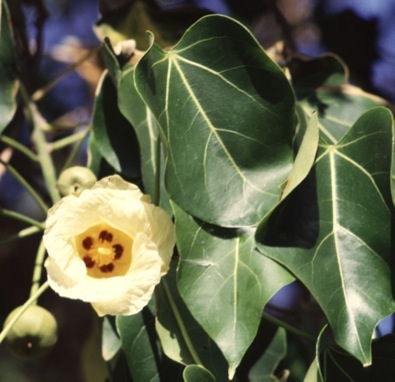Thespesia populnea: Coastal Cuisine
One of my uncles had the type of personality that where ever he hung his hat, that was home. The Milo is much the same way.
A probable native of India, one would think the Milo has spent all of creation in Florida and the Caribbean, it’s so at home in the environment. In truth, it is an escaped ornamental plant and in that regard rare. Ornamentals naturalize all the time but here in Florida they are usually toxic. The Milo is not. It is also cultivated in Central and South America and no doubt will soon be “at home” there as well. In fact, in the U.S. Virgin Islands it has taken over some beaches used by nesting sea turtles. In Florida it is found from about the space center and Tampa southward.
The Milo doesn’t like to be cold but can take mild frosts once established. It resists salt, spray, wind and grows happily on the shores of bays and inlets. It can live on silty land, coral, sand dunes and soil of high rock content. Like the mangroves, it provides shelter and food to many denizens of the coastal swamps. We can eat it, too. Young leaves, buds, and flowers are edible raw or cooked.
The Milo makes excellent wood for carving, the bark can be used for cordage, and for caulking. In West Africa the leaves are used to wrap food. Medicinally, the Milo has been used throughout Polynesia. A decoction of the leaves has been used to treat coughs and headaches, an infusion of the bark to treat intestinal diseases, and a drink from the leaves and bark to treat fevers in teething babies. Plant extracts have anti-viral and anti-bacterial activity.
The botanical name, Thespesia populnea, means “divine” and “like the poplar.” Said thess-PEEZ-ee-uh pop-ULL-nee-uh, the divine part refers to the flower and the leaves do resemble the leaves of the popular, a cold climate tree. Also don’t confuse the Milo with a close cousin, the Mahoe, (Hibiscus tiliaceus) see separate entry. The Milo has seven prominent veins in the leaf. The Mahoe has nine or eleven. The Mahoe also has dense star-shaped hairs on lower leaf surfaces, the Milo does not. Don’t confuse either with another close cousin, the Hibiscus pernambucensis which has solid-yellow flowers, without the dark center. See a separate entry for H. pernambucensis.
Green Deane’s “Itemized” Plant Profile
IDENTIFICATION: Shrub or tree to 50 feet, leaves heart-shaped, two to five inches long, flowers hibiscus-like but cupped to three inches long, crinkled, pale yellow when first opened with purple-red throat, dark red by end of day, can stay on tree for several days, seeds brown, 3/8 inch by 1/4 inch long.
TIME OF YEAR: Flowers spring and summer, young leaves year round.
ENVIRONMENT: Coastal hammocks, shoes, bays, inlets, keys, mainland, landscaping.
METHOD OF PREPARATION: Young leaves, buds, and flowers raw or cooked. Flowers can be boiled or batter dipped and fried.



Here in Hawai’i, we have a Milo tree that bears a fruit; a dry, flattened globe with 5 segments an about an inch in diameter. Would you happen to know if this fruit were edible as well?
I could try to answer that but a better idea is for you to send it to Nat Bletter, who is a foraging PHD in Hawaii. You can find his email address by clicking on foraging instructors which is a drop down menu under foraging.